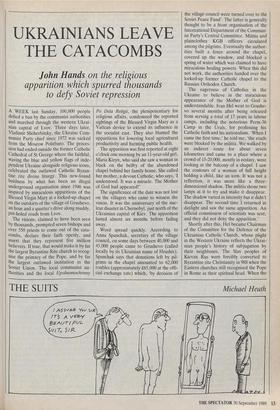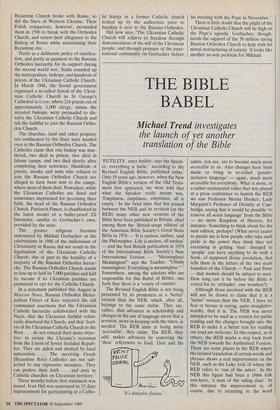UKRAINIANS LEAVE THE CATACOMBS
Jahn Hands on the religious
apparition which spurred thousands to defy Soviet repression
A WEEK last Sunday, 100,000 people defied a ban by the communist authorities and marched through the western Ukrai- nian capital of Lvov. Three days later, Vladimir Shcherbitsky, the Ukraine Com- munist Party chief since 1972 was sacked from the Moscow Politburo. The proces- sion had ended outside the former Catholic Cathedral of St George where the faithful, waving the blue and yellow flags of inde- pendent Ukraine alongside religious icons, celebrated the outlawed Catholic Byzan- tine rite divine liturgy. This new-found boldness by what has been an illegal underground organisation since 1946 was inspired by miraculous apparitions of the Blessed Virgin Mary at a locked-up chapel on the outskirts of the village of Grushevo, an hour and a quarter's drive along muddy, pot-holed roads from Lvov.
The visions, claimed to have been seen by thousands, prompted seven bishops and over 550 priests to come out of the cata- combs, declare their faith openly, and assert that they represent five million believers. If true, that would make it by far the largest Byzantine Rite church to recog- nise the primacy of the Pope, and by far the largest outlawed institution in the Soviet Union. The local communist au- thorities and the local Upolnomochenny Po Dela Religii, the plenipotentiary for religious affairs, condemned the reported sightings of the Blessed Virgin Mary as a Vatican device to extend its influence in the socialist east. They also blamed the apparitions for lowering local agricultural productivity and harming public health.
The apparition was first reported at eight o'clock one morning by an 11-year-old girl, Maria Kizyn, who said she saw a woman in black on the belfry of the abandoned chapel behind her family home. She called her mother, a devout Catholic, who says, 'I understood. It was a miracle. The Mother of God had appeared!'
The significance of the date was not lost on the villagers who came to witness the vision. It was the anniversary of 'the nuc- lear disaster in Chernobyl, just north of the Ukrainian capital of Kiev. The apparition lasted almost six months before fading away.
Word spread quickly. According to Anna Spanchak, secretary of the village council, on some days between 40,000 and 45,000 people came to Grushevo (called locally by its Ukrainian name of Hrushiv). Spanchak says that donations left by pil- grims in the chapel amounted to 62,000 roubles (approximately £65,000 at the offi- cial exchange rate) which, 'by decision of the village council were turned over to the Soviet Peace Fund'. The latter is generally thought to be a front organisation of the International Department of the Commun- ist Party's Central Committee. Militia and plainclothes KGB officers circulated among the pilgrims. Eventually the author- ities built a fence around the chapel, covered up the window, and blocked a spring of water which was claimed to have miraculous healing powers. When this did not work, the authorities handed over the locked-up former Catholic chapel to the Russian Orthodox Church.
The eagerness of Catholics in the Ukraine to believe in the miraculous appearance of the Mother of God is understandable. Ivan Hel went to Grushe- vo several months after being released from serving a total of 17 years in labour camps, including the notorious Perm-36 Camp in the Urals, for professing his Catholic faith and his nationalism. 'When I came the first time,' he told me, 'the roads were blocked by the militia. We walked by an indirect route for about seven kilometres and came to a place where a crowd of 15-20,000, mostly in ecstasy, were looking at the balcony of a chapel. I saw the contours of a woman of full height holding a child, like an icon. It was not a reflection, it was more like a three- dimensional shadow. The militia shone two lamps at it to try and make it disappear. The shadow varied in intensity but it didn't disappear. The second time I returned in daylight and saw the same apparition. An official commission of scientists was sent, and they did not deny the apparition.'
Shortly after this, Hel became Chairman of the Committee for the Defence of the Ukrainian Catholic Church, whose plight in the Western Ukraine reflects the Ukrai- nian people's history of subjugation by their neighbours. The Slav peoples of Kievan Rus were forcibly converted to Byzantine rite Christianity in 988 when the Eastern churches still recognised the Pope in Rome as their spiritual head. When the Byzantine Church broke with Rome, so did the Slays of Western Ukraine. Their Polish conquerors, however, persuaded them in 1596 to break with the Orthodox Church, and renew their allegiance to the Bishop of Rome while maintaining their Byzantine rite.
Partly as a deliberate policy of russifica- tion, and partly as payment to the Russian Orthodox hierarchy for its support during the second world war, Stalin rounded up the metropolitan, bishops, and hundreds of priests of the Ukrainian Catholic Church. In March 1946, the Soviet government organised a so-called Synod of the Ukrai- nian Catholic Church in St George's Cathedral in Lvov, where 216 priests out of approximately 3,000 clergy, minus the arrested bishops, were persuaded to dis- solve the Ukrainian Catholic Church and tell the faithful to join the Russian Ortho- dox Church.
The churches, land and other property not confiscated by the State were handed over to the Russian Orthodox Church. The Catholics claim that one bishop was mur- dered, two died in prison, two died in labour camps, and two died shortly after completing their sentences. Hundreds of priests, monks and nuns who refused to join the Russian Orthodox Church are alleged to have been sent to the camps, where most of them died. Nowadays, while the Ukrainian Catholics are fined and sometimes imprisoned for practising their faith, the head of the Russian Orthodox Church, Patriarch Pimen, is chauffeured in the latest model of a bullet-proof Zil limousine, similar to Gorbachev's own, provided by the state.
The greater religious freedom announced by Mikhail Gorbachev at the celebrations in 1988 of the millennium of Christianity in Russia did not result in the legalisation of the Ukrainian Catholic Church, due in part to the hostility of a majority of the Russian Orthodox hierar- chy. The Russian Orthodox Church stands to lose up to half its 7,000 parishes and half its income if its Ukrainian parishes are permitted to opt for the Catholic Church.
In a statement published this August in Moscow News, Russian Orthodox Metro- politan Filaret of Kiev repeated the old communist assertions that the Ukrainian Catholic hierarchy collaborated with the Nazis, that the Ukrainian faithful volun- tarily dissolved the Church, and that 'lead- ers of the Ukrainian Catholic Church in the West . . . do not conceal their main objec- tive: to secure the Ukraine's secession from the Union of Soviet Socialist Repub- lics. They are aided and abetted by local nationalists. . . . The surviving Greek (Byzantine Rite) Catholics are not sub- jected to any repressive measures. They can profess their faith . . . and pray in Catholic churches on Ukrainian territory.'
Three months before that statement was issued, Ivan Hel was sentenced to 15 days imprisonment for participating in a Catho- lic liturgy in a former Catholic church locked up by the authorities prior to handing it over to the Russian Orthodox.
Hel now says, 'The Ukrainian Catholic Church will achieve its freedom through demonstrations of the will of the Ukrainian people, and through pressure of the inter- national community on Gorbachev before his meeting with the Pope in November.'
There is little doubt that the plight of the Ukrainian Catholic Church will be high on the Pope's agenda. Gorbachev, though, needs the support of the 50 million strong Russian Orthodox Church to help with his moral restructuring of society. It looks like another no-win problem for Mikhail.



























































 Previous page
Previous page